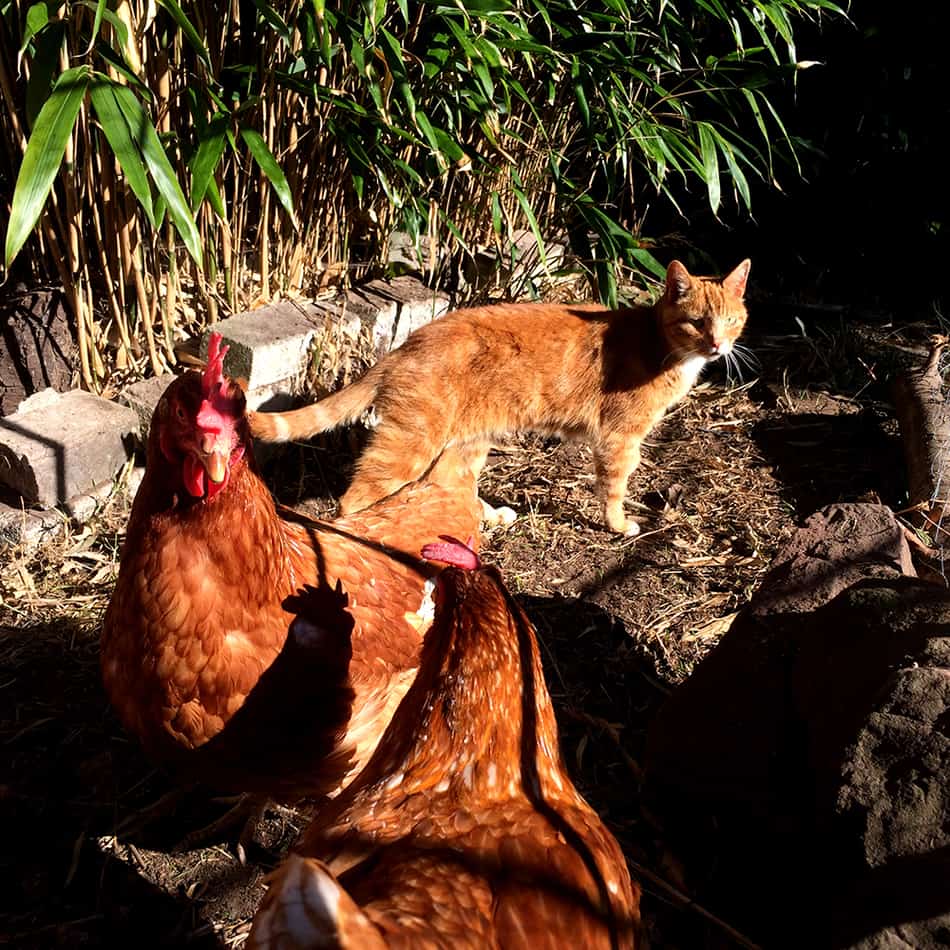Table of contents
Introduction
Learning how to keep chickens in a suburban area is an exciting and practical step toward sustainable living. Many people think a large yard or rural setting is necessary, but that’s not the case. With the right setup, even a small backyard can become a welcoming home for happy, healthy hens.
What You’ll Learn in This Guide:
- Choosing the Right Breeds – Find out which chicken breeds adapt best to suburban environments.
- Setting Up a Functional Coop – Learn how to build a secure, well-ventilated space to keep your flock safe and comfortable.
- Feeding and Maintenance – Get practical tips on providing a balanced diet while avoiding harmful foods.
- Addressing Common Challenges – Discover how to handle issues like predators, legal restrictions, and seasonal care.
Why Keep Chickens?
- Fresh Eggs – Enjoy delicious, organic eggs straight from your backyard. A hen’s diet and breed affect egg quality, often resulting in richer yolks and more nutritious eggs.
- Sustainability – Reduce food waste by feeding chickens safe kitchen scraps. Their bedding and manure, when properly composted, create excellent garden fertilizer.
- A Rewarding Hobby – Raising chickens brings a sense of fulfillment and fosters a stronger connection to nature.
Important Considerations
- Space Requirements – Each chicken needs 2-3 square feet inside the coop and 8-10 square feet in an outdoor run to stay active and healthy.
- Legal Restrictions – Some suburban areas limit flock sizes or prohibit roosters due to noise concerns. Always check your local regulations before getting started.
- Predator Protection – Even in the suburbs, threats like foxes and raccoons exist. A sturdy coop and secure fencing are essential to keeping your flock safe.
By the end of this guide, you’ll have the tools and knowledge to create a thriving backyard flock.
Why Keep Chickens in the Suburbs?
Benefits of Keeping Chickens
Learning how to keep chickens in a suburban setting is both practical and rewarding. Here’s why backyard chickens can be a great addition to your home:
- Fresh, Organic Eggs – Imagine collecting warm, freshly laid eggs every morning. Home-raised eggs often have a richer flavor and higher omega-3 content, depending on the hens’ diet.
- Sustainability – Chickens naturally reduce food waste by eating kitchen scraps. However, some foods—like avocado, chocolate, and raw potato peels—are toxic and should be avoided. Their droppings also make excellent compost, but fresh manure is nitrogen-rich and needs proper composting before use.
- Connection to Nature – Caring for chickens brings a deeper connection to nature. Watching their behaviors and routines is both fascinating and calming.
- Educational Value – Raising chickens teaches responsibility, sustainability, and the food cycle, making it a great activity for families.
A Personal Touch
When I first started keeping chickens in the suburbs, I was amazed by how much joy they brought to my daily life. Collecting eggs felt like discovering little treasures, and watching them explore the garden became one of my favorite pastimes. This guide will help you experience that same satisfaction.
Addressing Common Concerns
Many people worry that suburban chickens might be too noisy, require too much space, or bother neighbors. However, with proper planning, these concerns are easy to manage:
- Space Constraints – You don’t need a large yard to raise chickens successfully. Each hen needs 2-3 square feet inside the coop and 8-10 square feet in an outdoor run. Even a small garden can accommodate a flock with an efficient setup.
- Noise – Hens are much quieter than most household pets. While they do make some noise—especially when laying eggs—they are far less disruptive than a barking dog. To maintain a peaceful environment, it’s best to avoid roosters, as they crow loudly throughout the day.
- Neighbors – Open communication with your neighbors can prevent potential issues. Some areas require written neighbor approval or set limits on flock sizes. Sharing fresh eggs is a great way to build goodwill and keep the peace!
With thoughtful preparation, keeping chickens in the suburbs can be a rewarding and enriching experience that enhances your home and lifestyle.
Getting Started
Choosing the Right Breed
Selecting the right chicken breed is essential for a smooth and enjoyable suburban chicken-keeping experience. Some breeds adapt better to smaller spaces and quieter environments. Here are a few excellent choices:
- Sussex – Friendly, quiet, and excellent egg layers.
- Rhode Island Red – Hardy and productive, though they can be more assertive.
- Plymouth Rock – Docile, adaptable, and well-suited for suburban settings.
- Silkie – Small and quiet, making them great for families with children, though they tend to go broody often.
- Orpington – Gentle, quiet, and reliable layers—ideal for suburban homes.
When choosing a breed, consider:
- Egg Production – Some breeds lay more eggs per year than others.
- Temperament – If you have children or close neighbors, a calm and friendly breed is best.
- Climate Adaptability – Certain breeds handle heat or cold better than others, so pick one suited to your region.
Space Requirements
Understanding how to keep chickens in a suburban setting means ensuring they have enough room to stay healthy and comfortable.
- Coop Size – Each chicken needs at least 2-3 square feet inside the coop.
- Run Space – Provide 8-10 square feet per bird in an enclosed outdoor run to allow for movement and foraging.
- Portable Chicken Tractors – A great option for small backyards, though they require frequent relocation to prevent overgrazing.
- Maximizing Small Gardens – Use vertical space by adding perches and roosting bars to make the most of your available area.
Legal Requirements
Before getting chickens, check your local regulations and homeowners’ association rules to avoid any surprises.
- Flock Size Limits – Many suburban areas cap the number of chickens allowed (e.g., 3-6 birds per household).
- Rooster Bans – Since roosters can be loud, many local ordinances prohibit them in residential areas.
- Minimum Coop Distance – Some regulations require coops to be set a specific distance from property lines (e.g., 10-20 feet).
- Health & Safety Rules – Local guidelines may include coop placement, sanitation requirements, and waste disposal standards.
- Neighbor Relations – Keeping an open line of communication with neighbors can prevent conflicts. Offering fresh eggs now and then is a great way to build goodwill!
By choosing the right breed, ensuring enough space, and following local regulations, you’ll set yourself up for a smooth and enjoyable backyard chicken-keeping experience.

Setting Up Your Chicken Coop
Essentials for the Coop
Understanding how to keep chickens successfully starts with a well-designed coop that ensures your flock stays safe, comfortable, and productive. Here’s what every coop needs:
- Nesting Boxes – Provide one nesting box per 2-4 hens to give them a cozy, private space for laying eggs.
- Perches & Roosting Bars – Chickens instinctively roost at night. Install 8-12 inches of perch space per bird, placing roosts higher up for security.
- Ventilation – Good airflow prevents moisture buildup and reduces the risk of respiratory issues. Install windows or roof vents for effective cross-ventilation.
- Security & Predator Protection – Use 1/4-inch hardware cloth instead of chicken wire, as it blocks predators more effectively. Secure coop doors with automatic locks or predator-proof latches to keep nocturnal threats out.
DIY Chicken Coop Ideas
If you’re looking for a budget-friendly or customized setup, consider these creative coop options:
- Upcycled Materials – Convert an old shed, pallet wood, or a playhouse into a functional coop. Just be sure to use non-toxic paint and treatments.
- Portable Chicken Tractors – Mobile coops let chickens graze on fresh grass while staying protected. However, they must be moved frequently to prevent overgrazing.
- Vertical Design – Maximize limited space by incorporating multiple levels for roosting and nesting.
Predator-Proofing Your Coop
Predators are a concern in both rural and suburban areas, so proactive protection is key. Here’s how to keep your flock safe:
- Bury Hardware Cloth – Stop digging predators by burying hardware cloth at least 12 inches deep or extending it outward in an apron shape for added security.
- Secure Coop Doors – Use carabiner latches or padlocks to prevent raccoons and other clever predators from opening doors.
- Layer Your Defenses – Motion-activated lights may deter nocturnal predators like foxes and owls, but over time, they can adapt. A combination of secure fencing, strong locks, and guardian animals like dogs or geese offers the best protection.
By building a sturdy coop and reinforcing security measures, you’ll create a safe and comfortable home where your chickens can thrive.
Feeding Chickens
What to Feed Chickens
Knowing how to keep chickens healthy starts with providing a balanced diet that keeps them productive and well-nourished. Here’s what they should eat:
- Layer Feed – A complete feed packed with essential nutrients, 16-18% protein, and calcium to support strong eggshells.
- Grains & Scratch Mixes – Corn, wheat, and barley make great treats but should not replace a balanced diet. Limit scratch grains to 10% of their daily intake to prevent nutritional imbalances.
- Fresh Greens & Vegetables – Leafy greens, herbs, and vegetable scraps add variety and nutrients. However, too much spinach can interfere with calcium absorption.
- Protein Sources – Mealworms, black soldier fly larvae, and cooked eggs provide extra protein. Avoid feeding raw eggs, as this can encourage egg-eating behavior.
Safe & Unsafe Foods for Chickens
Some foods benefit chickens, while others can be harmful.
Safe Foods:
- Fruits: Bananas, apples, and berries
- Vegetables: Carrots, cabbage, cucumbers, and dandelion leaves
- Grains & Seeds: Sunflower seeds, oats, and quinoa
Foods to Avoid:
- Raw potatoes & green tomatoes – Contain solanine, a toxic compound
- Onions – Can cause anemia in large amounts
- Avocado (pit & skin) – Contains persin, which is toxic to chickens
- Chocolate, caffeine, and sugary foods – Harmful and unhealthy
For a detailed guide, check out What Can I Feed My Backyard Chickens?
Watering Chickens
Clean, fresh water is just as important as food. Follow these best practices:
- Provide one gallon of water per 4-5 chickens daily.
- Use a heated water dispenser in winter to prevent freezing, or float a small ball in the water to slow ice formation.
- Clean waterers regularly to prevent bacteria buildup and disease.
Supplementing Their Diet
Natural supplements can boost your flock’s health and egg production:
- Apple Cider Vinegar – Supports digestion and immunity when diluted (1 tbsp per gallon of water). Read more: Is Apple Cider Vinegar Good for Chickens?
- Eggshells or Oyster Shells – Provide extra calcium for strong eggshells. Offer separately so hens can self-regulate their intake. Can I Feed Chickens Eggshells?
- Grit – Essential for digestion, especially for chickens that don’t free-range.
By offering a well-balanced diet and clean water, you’ll ensure your chickens stay healthy, happy, and lay high-quality eggs.
Challenges and Solutions
Common Issues in Keeping Chickens
Learning how to keep chickens successfully is incredibly rewarding, but it does come with challenges. Here’s how to address some of the most common issues and keep your flock happy and secure:
1. Predators and Security
- Problem: Foxes, raccoons, and birds of prey pose a constant threat to backyard chickens.
- Solution: Replace chicken wire with 1/4-inch hardware cloth, which is far more effective at keeping predators out. Lock coops at night with secure latches or automatic doors to prevent break-ins. While motion-activated lights can deter some predators, combining lights, secure fencing, and guardian animals offers the best protection.
2. Rodent Infestations
- Problem: Mice and rats are attracted to spilled feed and open food sources.
- Solution: Store feed in sealed, rodent-proof containers, use treadle feeders to minimize waste, and clean up any spilled food immediately. Removing food and water at night can also discourage rodents from lingering.
3. Cold Weather Challenges
- Problem: In winter, chickens can suffer from frostbite and decreased egg production.
- Solution: Insulate the coop while maintaining proper ventilation to prevent moisture buildup, which can lead to frostbite. Apply petroleum jelly to combs and wattles for extra protection. Use heated water dispensers or float a small ball in water to slow freezing.
4. Hot Weather Problems
- Problem: Heat stress can cause dehydration and reduce egg production.
- Solution: Provide plenty of shade, fresh water, and frozen treats to help chickens stay cool. Increase ventilation inside the coop and wet shaded areas to lower the ground temperature. Some breeds, like Leghorns, tolerate heat better than heavier breeds like Orpingtons.
5. Noisy Chickens
- Problem: While hens are quieter than roosters, they can still be noisy, which may bother neighbors.
- Solution: Choose quieter breeds like Silkies, Orpingtons, or Australorps. Ensure they have enough space, mental stimulation, and a consistent routine to reduce stress-related noise. Avoid sudden changes, as startled chickens tend to vocalize more.
6. Illness and Disease Prevention
- Problem: Chickens are prone to mites, respiratory infections, and internal parasites.
- Solution: Keep the coop clean and conduct regular health checks. Add diatomaceous earth (DE) or wood ash to dust baths to prevent mites and lice. Ensure proper ventilation to reduce ammonia buildup, which can cause respiratory issues. For gut health, supplement with apple cider vinegar (1 tbsp per gallon of water). Learn more in Is Apple Cider Vinegar Good for Chickens?.
By addressing these challenges early, you’ll create a safe, stress-free environment where your chickens can thrive.
The Cost of Keeping Chickens
Initial Setup Costs
Understanding how to keep chickens successfully includes planning for the upfront costs before bringing them home. Here’s a breakdown of what to expect:
- Coop & Run – Costs range from £150-£500. DIY coops can be more affordable, but pre-built models can exceed £500, especially if you choose predator-proofing upgrades like hardware cloth instead of chicken wire.
- Feeding & Watering Equipment – Budget £20-£50. Standard feeders and waterers are inexpensive, but automatic or treadle feeders cost more and help reduce waste and deter rodents.
- Bedding & Nesting Materials – Plan for £10-£30 per month. Using the deep litter method can help cut bedding costs over time.
- Initial Flock Purchase – Chick prices vary. Hybrid breeds cost around £5-£10 per bird, while heritage and purebred breeds range from £15-£50.
- Heating & Insulation (if needed) – £50-£150 for winter preparation. Most chickens don’t need heating, but proper insulation and ventilation prevent frostbite.
Ongoing Monthly Costs
While raising chickens comes with recurring expenses, careful planning can keep costs manageable. Here’s what to expect:
- Feed – £10-£25 per month, depending on flock size and diet. Organic or specialty feeds can cost £25+ per 20kg bag.
- Bedding Replacement – £10-£20 per month. The deep litter method can extend bedding lifespan and reduce costs.
- Health & Supplements – £5-£15 per month. Regular use of calcium supplements, apple cider vinegar, and diatomaceous earth supports chicken health and helps prevent expensive vet visits.
- Electricity (if using heated waterers or lighting) – £5-£15 per month. Heating is rarely necessary, but heated waterers prevent freezing in winter.
Cost-Saving Tips
Looking to cut costs while still providing excellent care? Try these budget-friendly strategies:
- DIY Chicken Coop – Build your own coop with reclaimed wood, but avoid chemically treated wood, as it can be toxic.
- Grow Your Own Feed – Reduce expenses by supplementing store-bought feed with homegrown greens, sprouted grains, and mealworms.
- Buy in Bulk – Save money by purchasing feed and bedding in bulk, but store it properly to prevent spoilage and rodent issues.
- Use Natural Remedies – Minimize vet bills by keeping the coop clean and using apple cider vinegar (Is Apple Cider Vinegar Good for Chickens?) as a natural health booster. Adding diatomaceous earth to bedding also helps prevent mites and parasites.
By planning ahead and making smart financial choices, you can enjoy the rewards of raising chickens without breaking the bank.
Frequently Asked Questions (FAQ)
How many chickens should I start with?
For beginners, it’s best to start with 3-5 hens. This provides a good balance between manageable care and a steady supply of eggs. Chickens are social animals, so keeping at least three ensures they remain happy and engaged.
Can I keep chickens without a rooster?
Yes! Hens will lay eggs without a rooster. Roosters are only necessary if you plan to hatch fertilized eggs. Keeping a flock without a rooster also reduces noise concerns in suburban areas. Some local regulations prohibit roosters, so always check your area’s rules before deciding.
How do I prevent my chickens from escaping?
- Ensure your run has secure fencing at least 5-6 feet high, as some breeds can fly over 4 feet.
- Clip their wings if necessary (only one wing to create imbalance and reduce lift).
- Regularly inspect for gaps or weak spots in the fence.
Do chickens attract rats?
Chickens themselves don’t attract rats, but leftover feed and food scraps can. Prevent infestations by:
- Using rodent-proof feeders (such as treadle feeders).
- Storing feed in metal, rodent-proof containers.
- Cleaning up spilled feed daily and removing food at night.
What do I do if my chickens stop laying eggs?
There are several reasons why egg production slows down:
- Seasonal changes – Hens lay fewer eggs in winter due to shorter daylight hours. Providing 14-16 hours of supplemental light can maintain production.
- Molting – Chickens stop laying when they shed and regrow feathers, which lasts 6-12 weeks.
- Diet deficiencies – Ensure they receive 16-18% protein in their feed and access to calcium (oyster shells or crushed eggshells offered separately).
- Stress or illness – Changes in routine, predator threats, or health issues can impact laying.
How do I keep my chickens warm in winter?
- Use deep bedding (straw, wood shavings, or hemp) for insulation.
- Ensure the coop has proper ventilation to prevent moisture buildup and frostbite.
- Provide heated waterers or insulated water bowls to prevent freezing.
- Offer high-energy treats like cracked corn before bedtime to help chickens generate warmth overnight.
How much space do chickens need?
- Coop space: At least 2-3 square feet per bird (more is better).
- Run space: At least 8-10 square feet per bird.
- Free-range options: More space allows for healthier, happier chickens, but secure fencing is necessary to prevent escapes and predator attacks.
Can I let my chickens free-range in a suburban backyard?
Yes, but keep in mind:
- Supervision is essential to prevent predator attacks.
- A fenced area helps contain them and avoids conflicts with neighbors.
- Chickens can damage gardens by scratching and pecking. If left unsupervised, they may dig up plants and mulch.
What should I do if my chicken looks sick?
- Isolate the sick chicken from the flock.
- Check for symptoms like lethargy, respiratory issues, unusual droppings, or loss of appetite.
- Provide electrolytes, vitamins, and probiotics in water to aid recovery.
- Diatomaceous earth (DE) or wood ash in dust baths can help prevent mites and lice.
- Consult a vet if symptoms persist or worsen.
This FAQ provides quick answers to common questions about how to keep chickens successfully. For more in-depth guidance, explore our related articles on feeding, housing, and health management!
Conclusion
Keeping Chickens in a Residential Area
Understanding how to keep chickens in a suburban setting is a rewarding and sustainable way to enjoy fresh eggs, reduce food waste, and connect with nature. With the right setup and care, your backyard flock can thrive while adding value to your home and lifestyle. To keep everything running smoothly, it’s essential to manage waste properly, provide a nutritious diet, and follow local regulations. Since fresh chicken manure is high in nitrogen, compost it for at least 6-12 months before using it in gardens.
Key Takeaways
- Space & Legal Considerations: Check local regulations before getting chickens. Most suburban areas limit flock size to 3-6 birds and require coops to be 10-20 feet from neighboring properties. Roosters are often prohibited due to noise concerns.
- Proper Nutrition: Keep your flock healthy with 16-18% protein layer feed, separate calcium supplements (oyster shells or crushed eggshells), and treats limited to 10% of their diet. Free-ranging helps supplement their diet, but always provide a nutritionally complete feed. Learn more in What Can I Feed My Backyard Chickens?.
- Coop & Run Setup: Protect your chickens by using hardware cloth instead of chicken wire for fencing. Ensure good ventilation to prevent respiratory issues and frostbite. If using deep litter bedding, you can reduce cleaning to every six months with proper maintenance. For extra security, bury fencing at least 12 inches or use an outward apron to deter digging predators.
- Health & Maintenance: Keep the coop clean and monitor for common health issues like mites, respiratory infections, and egg-laying problems. Add diatomaceous earth (DE) or wood ash to dust baths to help prevent parasites. Using diluted apple cider vinegar (1 tbsp per gallon of water) supports gut health. Proper ventilation is key to preventing ammonia buildup from droppings. Learn more in Is Apple Cider Vinegar Good for Chickens?.
- Managing Costs: Raising chickens doesn’t have to be expensive. Store feed properly to prevent spoilage and rodent infestations. Save money by growing supplemental feed like mealworms, fodder, or garden scraps. Buying feed and bedding in bulk can also help lower costs.
Remember to register your flock with the Government if you are in the UK, you can do this on their website here.





